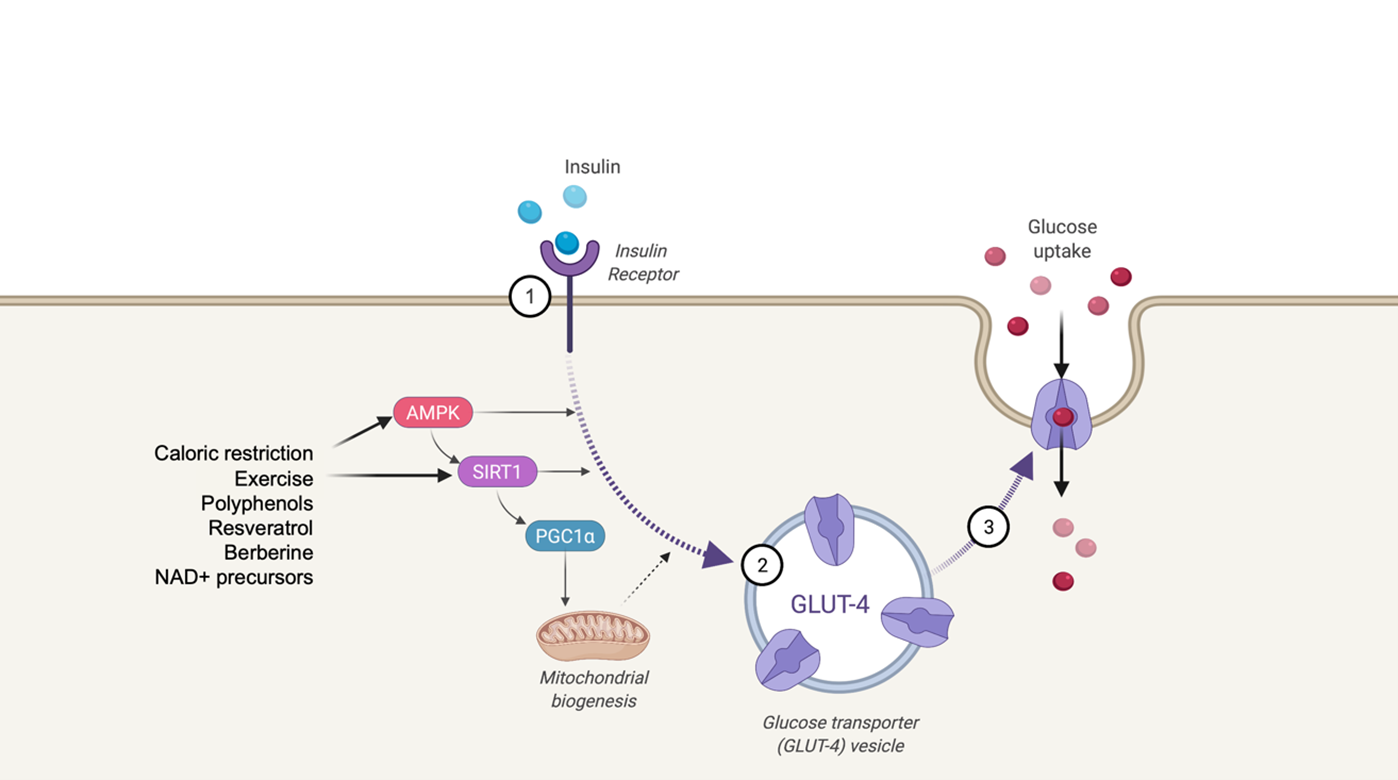This article offers insight into metabolic health and how to support AMPK activation.
Exercise regularly. Reduce calorie intake. Eat a balanced diet rich in fruits and vegetables.
Sound familiar?
This well-worn advice is older than most of our readership, but the underlying health-promoting mechanisms are more sophisticated than many modern medicines. Evolving research has deepened our understanding of the “how and why” behind lifestyle interventions for metabolic health, an area of endocrinology that encompasses insulin and glucose homeostasis, energy balance and body weight. Ample epidemiological, observational and prospective clinical trial data show that low-calorie diets and/or exercise programs enhance metabolic homeostasis in fairly predictable and partially redundant ways.
Exercising and fasting seem like different activities, but their effects converge and cooperate in signaling healthful changes in our metabolism, supporting beneficial adaptations that render cells more resilient and efficient. Exercise, calorie restriction and certain phytochemicals in plants activate AMP-activated protein kinase (AMPK), an energy “sensor’ that researchers describe as “the guardian of metabolism.”1
AMPK is activated whenever there’s an energy shortage. In these situations of “energetic stress,” the levels of cellular energy currency (adenosine triphosphate, or ATP) are low, while AMP (“spent” ATP) levels are high. This low-energy state (a low ATP:AMP ratio) potently stimulates AMPK, signaling the body to ramp up energy production and stop wasting fuel on frivolous affairs like cell growth and fat synthesis. Perhaps the most impactful and measurable short-term effect is insulin sensitization, which becomes noticeable when these healthy habits are sustained over several weeks to months. The effect is quite simple—AMPK ensures that glucose goes where it needs to (into cells where it can be utilized for energy) instead of circulating idly in the bloodstream.1, 2
Meeting energy demands is the specialty of mitochondria (famously called the “energy powerhouses”), which occupy the cytosol of a single cell, sometimes by the hundreds to thousands. AMPK ensures that mitochondria increase in number when there’s an energy deficit (a process called mitochondrial biogenesis) and that old and damaged ones are removed (known as mitophagy). In simple terms, AMPK helps to refurbish mitochondrial networks, much like replacing all the light bulbs in your home. Healthier mitochondria support the net movement of glucose into cells (Figure 1).1, 3

Figure 1. The AMPK-SIRT1 axis supports glucose uptake by cells. AMPK activates sirtuin 1 (SIRT1) and PPAR-gamma coactivator 1 alpha (PGC-1α) to induce mitochondrial biogenesis, which supports the function of insulin after it binds to its receptor (1), encouraging the movement of glucose transporters to the membrane (2) where glucose enters the cell to be used for energy. Image created with BioRender.com.
The benefits of AMPK activation go far beyond glucose disposal. AMPK promotes autophagy (derived from the Greek phrase “eating of self”), a process that degrades dysfunctional cells and allocates their parts and substrates toward the repair, fueling and restoration of healthier cells.4 The AMPK-SIRT1 axis is a major conduit by which caloric restriction (CR) prolongs lifespan and “healthspan” (the duration of optimal health over the lifespan) in multiple animal models.5
Some of the adaptations elicited by AMPK curtail energy-consuming processes, like cell growth and fat synthesis. For example, AMPK inhibits the proliferation of smooth muscle cells that line arteries by arresting them in the middle of the cell cycle, which helps to maintain the normal thickness of the vessel wall.1, 6 AMPK also reduces hepatic cholesterol synthesis by inhibiting HMG CoA reductase and interferes with enzymes that synthesize fatty acids in adipose tissue.
In skeletal muscle, AMPK slows cell growth (hypertrophy). This is a temporary state that switches to anabolism when a meal is consumed. Paradoxically, AMPK activation may support post-prandial anabolism and protein synthesis by improving the insulin sensitivity of muscle cells. Therefore, athletes trying to build muscle should include periods of low-energy intake or fasting as part of their dietary regimen. After all, insulin is the most powerful anabolic hormone in mammals. Taking advantage of AMPK could be as simple as cutting out snacks between meals or extending the overnight fasting period.
PRACTICAL WAYS TO BOOST AMPK
- Stop snacking. Allow the body to enter a mini-fast between meals (at least 6 hours). Exercising during this time, even if it’s a 10-minute walk, will expedite the onset of the energy deficit that’s needed to activate AMPK. Walking for just a few minutes after a meal, and even taking standing breaks while sitting, can kickstart this energy shift.7
- Caloric restriction (CR) is the most extensively studied dietary method to up-regulate AMPK. Ample research has shown that limiting calorie intake, even modestly, enhances insulin sensitivity and metabolic regulation.1, 8 In practice, caloric restriction is difficult to deploy because of low patient compliance. Alternative protocols involving alternate day fasting (ADF) may offer similar health benefits with better long-term adherence.8 Modest reductions in overall energy intake can also activate AMPK, but it’s important to allow blood sugar to drop sufficiently between meals to engage it.
- Exercise is perhaps the most sustainable and well-supported method. Any exercise will suffice, as long as it burns calories and creates a temporary energy deficit. It’s important to avoid snacking before or during the workout.
- CR mimetics (CRMs) are small molecules that may partially recapitulate the cellular effects of CR.9, 10 CRMs lacked a unified definition until 2014 when Madeo and colleagues defined them as substances that inhibit protein acetylation, which “tunes up” metabolism, mitochondrial renewal and longevity pathways.9 To learn more, here is a short article describing CRMs.
- Resveratrol has been shown to support the AMPK/SIRT1 axis and mitochondrial function at daily doses of at least 150 mg/day.11, 12‡
- Berberine supports insulin receptor function and signaling, in part, by supporting AMPK activation. Human clinical trials have shown significant metabolic health benefits after 4-12 weeks of daily supplementation with 1000-1500 mg/day.13, 14 Berberine has very poor oral bioavailability, but new delivery systems can overcome this limitation. Berbervis® phytosome is 4x more bioavailable than a standard berberine formulation.15‡
- Nicotinamide riboside and nicotinamide mononucleotide (NMN) support metabolic health by mimicking a low-acetylation state. By supplying NAD+, they directly activate SIRT1. NAD+ is made from dietary niacin and its biosynthesis declines with age.5‡
- Polyphenols in fruits, berries, green tea and other plant foods support the AMPK-SIRT1 axis and other pathways related to cardiometabolic health.16‡
SUMMARY & KEY POINTS
- AMPK is a master metabolic sensor that enhances mitochondrial function, insulin signaling and glucose metabolism.
- Lifestyle interventions that create energy deficits, such as caloric restriction and exercise, are well-established modalities that activate the AMPK-SIRT1 axis.
- Various phytochemicals, such as polyphenols from fruits and vegetables and resveratrol and berberine, also support AMPK and/or SIRT1 activity.
FOR FURTHER LEARNING
Free online course: Integration of Pharmaceuticals and Natural Products in Cardiometabolic Care
In this complimentary mini-course (60-90 minutes, at your own pace), learn how to integrate evidence-based diet and lifestyle approaches in basic cardiometabolic care.
REFERENCES
- Herzig S, Shaw R. Nat Rev Mol Cell Biol 19, 121–135 (2018).
- Burkewitz K, Zhang Y, Mair WB. Cell Metab. 2014 Jul 1;20(1):10-25.
- Smith BK, Steinberg GR. Curr Opin Clin Nutr Metab Care. 2017 Jul;20(4):248-253.
- Nakamura S, Yoshimori T. Autophagy and Longevity. Mol Cells. 2018 Jan 31;41(1):65-72.
- Dai H, Sinclair DA, Ellis JL, Steegborn C. Pharmacol Ther. 2018 Aug;188:140-154.







